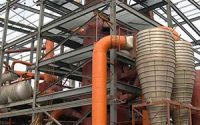Soybean extraction process
Seed oils represent 70% of global oil production, of which 30% is soybean oil. Oilseeds are the most important export items in Argentina.
In oilseeds, the vacuoles within cells contain oil, and both cell walls and vacuoles have to be broken in order to improve solvent extraction. Therefore, the preparation of the seed before solvent extraction is critical to maximize oil recovery.
An alternative pretreatment to facilitate the release of oil from the seed could be enzymatic degradation. In this way, the partial hydrolysis of soybean seed cell structures with appropriate enzymes would increase permeability, which would in turn increase mass transfer. An enzymatic treatment stage could be incorporated for industrial purposes without significant changes to conventional processes. The oil release obtained using this method could result in a higher extraction yield and/or smaller quantities of the organic solvents used.
In solvent extraction, pretreated oilseeds (porous solid matrix) come into contact with a pure solvent or a solvent mixture (miscella) to transfer the oil from the solid matrix to the liquid medium. While the principle of extraction is relatively simple, it is a complex mechanism. In order to describe this process, the mass transfer phenomena involved and the eventual resistance to mass transfer in the solid phase (solid soybean) and in the liquid phase (hexane) should be analyzed. This process involves several phenomena: oil is diffused through the internal pores to the surface of the solid (internal mass transport) and is then passed to the bulk liquid by means of a convective mechanism produced by the concentration difference between the solution occluded in the pores and the bulk solution (external transport). Because the oil to be extracted is contained within an insoluble solid network with occluded miscella, the diffusion occurs mainly between the occluded solution and the solid, greatly affecting the extraction rate since the solid matrix resists diffusive transport .
The rate of conventive and diffusive mass transfer can be expressed by means of equations that predict that the transfer is proportional to the difference between the bulk and the liquid-solid interface concentration. The mass transfer coefficient in the solid can be estimated from the effective diffusion coefficients, while the mass transfer coefficient in the liquid can be estimated from empirical correlations.
The purpose of this study is to evaluate multienzyme hydrolysis as a pretreatment option to improve soybean oil solvent extraction and, on the basis of the results obtained, to define a preparation stage adapted to existing industrial processes. For this evaluation, the optimum conditions for enzymatic treatment and the yield obtained in each case are determined first. Then, based on the reaction conditions optimized to maximize oil yield, the influence of the enzymatic hydrolysis on the diffusion as the rate-determining step is established. Finally, a mathematical model for column extraction was developed to describe the process as an approximation to the operation of an industrial system.


